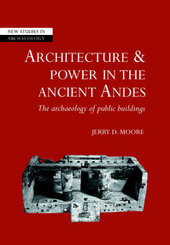
|
Architecture and Power in the Ancient Andes: The Archaeology of Public Buildings
Paperback / softback
Main Details
| Title |
Architecture and Power in the Ancient Andes: The Archaeology of Public Buildings
|
| Authors and Contributors |
By (author) Jerry D. Moore
|
| Series | New Studies in Archaeology |
|---|
| Physical Properties |
| Format:Paperback / softback | | Pages:276 | | Dimensions(mm): Height 244,Width 170 |
|
| Category/Genre | Public buildings - civic, commercial, industrial, etc |
|---|
| ISBN/Barcode |
9780521675635
|
| Classifications | Dewey:720.98 |
|---|
| Audience | | Professional & Vocational | | Tertiary Education (US: College) | |
|---|
| Illustrations |
1 Maps; 3 Halftones, unspecified; 3 Line drawings, unspecified
|
|
Publishing Details |
| Publisher |
Cambridge University Press
|
| Imprint |
Cambridge University Press
|
| Publication Date |
20 October 2005 |
| Publication Country |
United Kingdom
|
Description
In this innovative volume, Jerry D. Moore discusses public architecture in the context of the cultural, political and religious life of the pre-hispanic Andes. Archaeologists have invested enormous effort in excavating and documenting prehistoric buildings, but analytical approaches to architecture remain as yet undeveloped. Architecture and Power in the Ancient Andes uses new analytical methods to approach architecture and its relationship to Andean society, exploring three themes in particular: the architecture of monuments, the architecture of ritual, and the architecture of social control. It provides both a methodology for the study of public architecture and an example of how that methodology can be applied. Jerry D. Moore's clear and richly illustrated discussion represents an original perspective on architecture and its role in ritual, ideology, and power in the ancient world.
Reviews..".this book represents a good discussion of the architecture of the North Coast and Central Coast of Peru. This book calls attention to the importance of ritual architecture as a force of social and ritual transformation...I do recommend this book to anyone working on ancient architectual form and on applying new approaches to recognize archaeological patterning." Journal of Field Archaeology
|